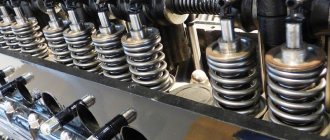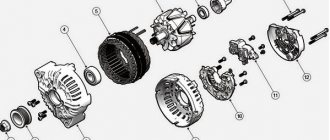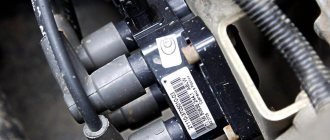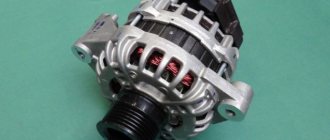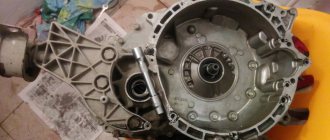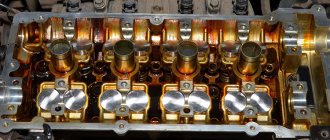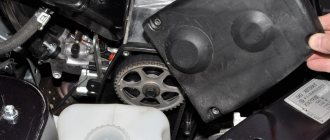The appearance of third-party sounds in the operation of the power unit is caused by a violation of the gaps in the gas distribution mechanism (GRM). Most motorists rush to adjust the valves, but this does not always help.
The valve knock on the Grant may become quieter, but will not disappear altogether. Often the reason lies in worn hydraulic compensators. Unprofessional intervention in repairs can only harm the operation of the unit, so use the services of certified workshops.
Causes of knocking valves in Lada Granta
- Increased camshaft cam clearance.
Note to the driver!
For each technical device, the manufacturer sets an individual gap. For example, for the Lada Granta Sedan / Liftback it is 0.25 mm inlet, 0.40 mm exhaust.
- A reduced gap is “contraindicated.” Clamping the valve body causes it to jam; it does not close the inlet port tightly. Long-term operation in this technical condition leads to a decrease in compression and failure of one/several cylinders.
It is important to know!
Periodic vehicle diagnostics every 10,000 km will prevent a number of breakdowns, including malfunction of the gas distribution mechanism.
Cylinder block
The block is cast from high-strength cast iron. Cylinder numbering is carried out on the installation side of the crankshaft pulley. Each cylinder, based on the results of measuring its diameter, is assigned a size class.
| Parameter | Meaning |
| Material | ductile iron |
| Cylinder diameter, mm | 82 |
| Intercylinder distance (distance between the axes of adjacent cylinders of the block), mm | 89 |
| Block height (distance between the upper plane of the block and the axis of the crankshaft), mm | 197,10 |
| Diameter of boring of crankshaft supports (for main bearings), mm | 54,52 |
| Weight, kg | 31,000 |
The cylinder block, although with its own index, is exactly like that of the VAZ-21126 engine: with additional nozzles for cooling the pistons with oil and plate-honing of the cylinder walls, which reduces the break-in time. Wall processing is carried out in accordance with the requirements of Federal Mogul. Block 21116 has three classes every 0.01 mm (A, B, C). The cylinder class mark is located on the bottom plane of the block.
Knocking or detonation. Signs and differences
Detonation in the engine of any technical vehicle, including the Lada Granta Sedan/Liftback, is similar to a small explosion with a shock wave. It is at the moment of explosion that the valve(s) knock.
The clattering noise is not always associated with faulty valves. It is necessary to conduct a thorough diagnosis followed by replacement of worn elements.
Signs of detonation:
- vibration increases as engine speed increases;
- black smoke from the vehicle exhaust system;
- a sharp decrease in engine power;
- frequent increase in operating temperature to a critical level.
Related link:
How to protect headlights from damage on a Lada Granta. Advice from experts
If the knocking noise occurs when the engine is “hot,” then the reason is insufficient engine oil level.
What to do in such a situation
It is important to understand that there is nothing good about valve knocks on a hot engine. The simplest solution would be to go to the nearest car service center, where specialists will check and fix everything.
But some people find it interesting and even useful to delve into the car themselves and gain new experience and knowledge. Someone will first have to read a lot of literature and technical documentation. Others will watch the video and easily repeat the manipulations done.
Although a similar problem occurs on many cars, it is the owners of inexpensive or quite old cars who prefer to take on knocking valves themselves, such as:
- Renault Logan;
- Chevrolet Niva;
- VAZ 2114;
- Lada Priora;
- VAZ 2106;
- Ford Focus;
- VAZ 2109;
- Opel Astra;
- Daewoo Nexia;
- Nissan Almera;
- Renault Sandero;
- Cherry Amulet, etc.
Don’t think that solving a knocking problem is very easy. If you make a mistake, you will only increase the noise and cause the situation to worsen. Therefore, beginners are not recommended to take on such work.
Before you begin disassembling, be sure to read the instruction manual specific to your car.
If we talk about the general repair scheme, it can be described approximately as follows:
- First you need to get to the valves themselves. To do this, remove the cylinder head plug and drain all the oil from the system;
- The camshaft is rotated so that the mark on the pulley coincides with the installation protrusion;
- You will probably have to check the distance between the valves and pushers by touch;
- Using the adjustment washer, the gap is changed and adjusted;
- Manipulations with the washer are carried out several times if necessary and depending on the engine itself;
- The assembly is assembled in the reverse order;
- Oil is poured;
- The presence of knocks is checked after the adjustment has been carried out.
If such actions do not produce any results, then there is no point in making further attempts at DIY repairs. It's better to send the car to a good car service center.
When the malfunction is not related to gaps, it will be extremely problematic to correct the situation on your own. But if the problem is an incorrect adjustment, you will spend a minimum of time and money restoring the engine’s performance. The valves will stop knocking when the engine is warm.
Any extraneous noise from the engine that doesn't go away and accompanies you on the road is a bad sign. It should not be ignored under any circumstances, as it may be a harbinger of much more serious problems than background noise.
Have you ever encountered valve knocking noises when the engine was warm? What was the reason and how did you eliminate it?
Thank you for being with us! Subscribe, leave comments, ask relevant questions!
( 1 ratings, average: 5.00 out of 5)
Did you like the article?
Subscribe to updates and receive articles by email!
We guarantee: no spam, only new articles once a week!
No matter how reliable the car is, the time comes when you are forced to go to a service station to diagnose and repair faults. At the same time, most of the breakdowns can be fixed with your own hands, but there are also those that only professionals can help fix. Valve knocking is a common problem, which in terms of difficulty of elimination is somewhere in the middle. In some cases, it is possible to identify the malfunction and make repairs on your own, while in others you have to turn to a specialist for help. Watch the video “Adjusting VAZ 2107 engine valves” below
How to diagnose a knock?
Without sufficient experience, car owners sometimes find it difficult to determine the problem by ear. This is not surprising, because the source of extraneous noise can be anything - the crankshaft, bearings, faulty belt and valves. But unlike other sounds, the knocking of valves reveals itself with a characteristic sonority, with a certain metallic tapping, near the gas distribution mechanism. In addition, unusual noise occurs regardless of engine speed.
In practice, it is not difficult to recognize that valves are knocking, but even experienced car owners sometimes fail to diagnose their malfunction. But to confirm or refute suspicions, you can make a diagnosis yourself. For this:
Valves knocking on Lada Grant during acceleration
There are modifications: 8 valve and 16 valve Lada Grants Sedan / Liftback. One pair of valves provides the intake of the combustible mixture, the other - the release of the exhaust gas flow.
When the motor reaches operating temperature, the metal parts expand. Incorrectly adjusted cold clearances contribute to the formation of knocking, rapid wear of parts, and a decrease in engine efficiency.
To level out the knocking of valves in the design of the Lada Granta Sedan / Liftback, hydraulic compensators (pushers) are used. They try to maintain permissible valve clearances as accurately as possible.
Self-adjustment method for valves
- In the engine compartment we remove attachments, decorative plates, and air ducts.
- Unscrew the valve cover.
- Jack up one side of the wheel and turn it until the shaft elbow is in the uppermost part.
- Use a metal feeler gauge to measure the valve clearance. Tighten and loosen the control nut as necessary.
By analogy, we complete the work in the remaining cylinders.
Checking hydraulic compensators of Lada Granta Sedan / Liftback
At home, identifying the source is extremely difficult, sometimes impossible. Work of this complexity is carried out in certified service stations using acoustic equipment.
Related link:
Adsorber Lada Granta: signs of malfunction, solutions, replacement
After the technician identifies the defective pushers, they must be removed, washed thoroughly, and reinstalled. If the hydraulic lifters are also knocking, then replace the elements with new ones.
Engine VAZ 11186 1.6 l
Experts consider the VAZ 11186 engine as a modernization of the 21114 engine, a secondary modification of the 21083, or an improvement in the characteristics of the 11183 internal combustion engine.
The first option is considered more correct, since the design of 11186 and 21114 is absolutely identical, with the exception of the pistons.
The 11186 engine is equipped with AvtoVAZ products, and the previous version of the internal combustion engine was equipped with pistons from the manufacturer Federal Mogul (USA), which developed it under a contract with the Volzhsky Automobile Plant.
ICE 11186 compared to 11183
Reviews
| № | Positive |
| 1. | Vasily: I drove a little more than 50,000 km, there is no knock in the gas distribution mechanism. I regularly fill up with high-octane fuel and fill in Shell 10W-40 semi-synthetic oil. |
| 2. | Konstantin: in two years of active operation of the machine, the valve knocked once. As the service station worker found out, the reason was that the fastening nut was not tightened sufficiently. Half an hour later I was driving the car again. |
| 3. | Vladlen: I recently noticed dark-colored exhaust gases coming from a car, I thought there was a problem with the gas distribution mechanism. During the diagnostics, it turned out that there was a violation in the enrichment of the mixture in the system, as a result of which carbon deposits formed. |
| 4. | Ignat: I heard a lot of complaints about the gas distribution mechanism, I didn’t have any breakdowns in a year and a half of using the car. Perhaps the reason is constant maintenance, careful handling, refueling with high-quality oils and fuel. |
| 5. | Ivan: in two years of using the car, I cleaned the gas distribution mechanism once for preventive purposes. The machine works stably, there are no complaints. |
| Negative | |
| 1. | Vitaly: after 55,000 km, the valves began to knock, I took the car to the service center, and it turned out that the leg was deformed. Replaced with new ones, they gave a guarantee. Dissatisfied with the quality of workmanship. |
| 2. | Kirill: at the first convenient opportunity, re-tighten the valve mechanism on the Lada Granta. Lots of defects, poor quality fitting, loose knots. |
| 3. | Slavik: in the third year of operation of the machine, I replaced the valve mechanism with a new one. The old one has fallen into disrepair. |
Conclusion
The average service life of the gas distribution mechanism of the Lada Granta does not exceed 50 - 60 thousand km. In order not to reduce the resource, periodically carry out preventative maintenance on your car, replace worn parts with new ones.
Refilling with high-quality motor oils and high-octane fuel will only increase the life of the valve mechanism.
Related link:
Replacing the Lada Granta generator bracket
Often, the cause of premature wear of timing elements is an aggressive driving style. Increased load and high temperatures contribute to premature wear of components.
Description
For the first time, the new VAZ-11186 power unit was presented to a wide range of the public in 2011. The motor was demonstrated at the Moscow Motor Show MASK in the Lada Kalina 2192.
The production of internal combustion engines is carried out at the production facilities of AvtoVAZ (Tolyatti).
The VAZ-11186 is a four-cylinder in-line naturally aspirated petrol engine with a volume of 1.6 liters and a power of 87 hp. s and a torque of 140 Nm.
Under the hood of the VAZ-11186
Installed on Lada and Datsun cars:
- Grant 2190-2194 (2011-present);
- Kalina 2192-2194 (2013-2018);
- Datsun On-Do 1 (2014-present);
- Datsun Mi-Do 1 (2015-present).
The engine is identical to its predecessor (VAZ-11183). The main difference lies in the CPG. Additionally, some assemblies and fastenings for service mechanisms have been updated.
The cylinder block remained traditionally cast iron. There are no significant structural changes.
Aluminum cylinder head. To increase strength, it is heat treated using a new process technology. The changes affected the increase in cooling channels. The head has a camshaft and eight valves.
Hydraulic compensators are not provided. The thermal clearance of the valves is adjusted manually. The combustion chamber has been increased to 30 cm³ (previously it was 26). This was achieved by reducing the thickness of the gasket and increasing the height of the cylinder head by 1.2 mm.
The pistons in the VAZ-11186 engine are lightweight and made of aluminum alloy.
On the left is a standard piston, on the right is a lightweight one
There are three rings, two of which are compression and one is oil scraper. Additional anodizing was performed in the area of the first ring, and a graphite coating was applied to the piston skirt. Piston weight 240 g. (serial – 350).
The piston configuration does not provide protection when meeting the valves in the event of a broken timing belt. But engines produced after July 2022 are free of this drawback - the pistons have become plugless. And the final touch - the VAZ-11186 piston group is completely manufactured at AvtoVAZ.
Timing belt drive, with automatic tensioner. The internal combustion engine is equipped with a Gates brand belt with an increased service life (200 thousand km). The shape of the belt cover has changed. Now it has become collapsible and consists of two parts.
On the right is the timing belt cover VAZ-11186
The automatic tension roller is also new.
On the right is a VAZ-11186 video
Receiver updated. An electromechanical throttle valve module (E-gas) is installed at its input. It is clear that the appearance of the receiver has changed.
The catcollector received separate entrances to the housing, which made it possible to reduce resistance when exhaust gases exit. In general, this contributed to a slight increase in the power of the internal combustion engine.
The generator bracket has become structurally more complex. It now has a timing belt tensioner pulley.
Engine cooling system. The heat exchanger became single-pass, the thermostat was replaced with a more advanced one. According to the manufacturer, the modification of the cooling system completely eliminated the possibility of engine overheating. (Unfortunately, on the internal combustion engine under consideration, the results of theory and practice do not always coincide).
In general, the changes implemented in the VAZ-11186 engine led to an increase in power, a decrease in exhaust toxicity and a decrease in fuel consumption.
